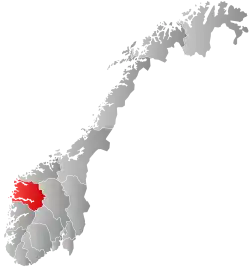Lavik og Brekke
Lavik og Brekke is a former municipality in the old Sogn og Fjordane county in Norway. It is in the present-day municipalities of Gulen and Høyanger in Vestland county. It was part of the traditional district of Sogn. The 427-square-kilometre (165 sq mi) municipality[1][2] was located along the Sognefjorden, at the western end of the fjord, just east of the mouth. The municipality existed from 1861 until 1905. The administrative center of Lavik og Brekke was the village of Lavik. There were two churches in the municipality: Lavik Church in Lavik on the north side of the fjord and Brekke Church in Brekke on the south side of the fjord.[3]
Lavik og Brekke herad | |
|---|---|
 View of Lavik village | |
 Sogn og Fjordane within Norway | |
 Lavik og Brekke within Sogn og Fjordane | |
| Coordinates: 61°06′17″N 05°30′37″E | |
| Country | Norway |
| County | Sogn og Fjordane |
| District | Sogn |
| Established | 1 Jan 1861 |
| • Preceded by | Lavik and Brekke municipalities |
| Disestablished | 1 Jan 1905 |
| • Succeeded by | Lavik and Brekke municipalities |
| Administrative centre | Lavik |
| Area | |
| • Total | 427 km2 (165 sq mi) |
| Population (1905) | |
| • Total | 2,164 |
| • Density | 5.1/km2 (13/sq mi) |
| Time zone | UTC+01:00 (CET) |
| • Summer (DST) | UTC+02:00 (CEST) |
| ISO 3166 code | NO-1415 |
History
Lavik og Brekke was established as a municipality in 1861 as a merger between the municipalities of Lavik and Brekke, which were located along the Sognefjorden. Before the merger, Lavik had 926 inhabitants and Brekke had 898, giving the new municipality a population of 1,824. On 1 January 1875, a part of Klævold municipality (to the west) with 90 inhabitants was moved to Lavik og Brekke. On 1 January 1905, the municipality was split, reverting to their previous borders, leaving Lavik and Brekke as separate municipalities once again. Before the split Lavik og Brekke had a population of 2,164. Both Lavik and Brekke were later incorporated into other municipalities, with Lavik joining Høyanger and Brekke joining Gulen.[4]
Name
The municipal name Lavik og Brekke (lit. 'Lavik and Brekke') was created as a compound name by combining the names of the two predecessor municipalities.
The first name comes from the old Lavik farm (Old Norse: Lámvíkum) since the first Lavik Church was built there. The first element has an uncertain meaning. One possibility is that it comes from the word hlað which means "pile" or "stack". The last element likely comes from the word vík which means "inlet" or "cove". Historically the spelling has varied greatly. It was Laduigh in the 16th century, Laduig in the 17th century, Ladvig in the 18th century, Ladevig in the 19th century, and finally Lavik in the 20th century.[5]
The second name comes from the old Brekke farm (Old Norse: Brekka) since the first Brekke Church was built there. The name is identical to the word brekka which means "slope". Historically, the spelling of the name was not formalized until the 1800s, so spellings such as Breche, Bræcke, and Brække were also used.[6][7]
Government
During its existence, this municipality was governed by a municipal council of directly elected representatives. The mayor was indirectly elected by a vote of the municipal council.[8]
References
- Askheim, Svein, ed. (2019-01-02). "Lavik". Store norske leksikon (in Norwegian). Kunnskapsforlaget. Retrieved 2019-09-29.
- Askheim, Svein, ed. (2019-09-23). "Brekke - Gulen". Store norske leksikon (in Norwegian). Kunnskapsforlaget. Retrieved 2019-09-29.
- Thorsnæs, Geir, ed. (2014-09-21). "Lavik og Brekke". Store norske leksikon (in Norwegian). Kunnskapsforlaget. Retrieved 2019-09-29.
- Jukvam, Dag (1999). Historisk oversikt over endringer i kommune- og fylkesinndelingen (PDF) (in Norwegian). Statistisk sentralbyrå. ISBN 9788253746845.
- Rygh, Oluf (1919). Norske gaardnavne: Nordre Bergenhus amt (in Norwegian) (12 ed.). Kristiania, Norge: W. C. Fabritius & sønners bogtrikkeri. pp. 183–184.
- Arthur, Ross G. (2002). English-Old Norse Dictionary (PDF). Cambridge, Ontario, Canada.
{{cite book}}: CS1 maint: location missing publisher (link) - Rygh, Oluf (1919). Norske gaardnavne: Nordre Bergenhus amt (in Norwegian) (12 ed.). Kristiania, Norge: W. C. Fabritius & sønners bogtrikkeri. pp. 190–193.
- Hansen, Tore; Vabo, Signy Irene, eds. (2022-09-20). "kommunestyre". Store norske leksikon (in Norwegian). Kunnskapsforlaget. Retrieved 2023-01-01.
- "Ordførarar i Høyanger kommune". NRK Fylkesliksikon (in Norwegian). 2003-11-07. Retrieved 2023-06-20.
External links
 Sognefjord travel guide from Wikivoyage
Sognefjord travel guide from Wikivoyage

